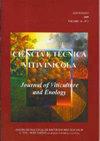大豆分离蛋白在红酒精制中的应用
IF 1.1
4区 农林科学
Q4 FOOD SCIENCE & TECHNOLOGY
引用次数: 1
摘要
大豆分离蛋白被评价为一种潜在的精制剂,可以替代主要的商业蛋白质精制剂(卵清蛋白、猪明胶和豌豆分离蛋白)。两种红葡萄酒(cv。梅洛(Merlot)和cv。’Lambrusco Maestri’)的鱼鳍,装瓶,并分析酚含量,颜色,浊度和感官特征。与所用的蛋白质无关,细化促进了大部分酚类化合物的减少,轻微(但显著)降低了颜色特性,并降低了葡萄酒的浑浊度。在所有处理中,还观察到涩味、持久性、苦味和酒体的减少,以及亮度、清晰度和酸度的增加。大豆分离蛋白的应用在物理化学和感官测量方面与其他商业精制剂取得了相似的结果,这有利于大豆分离蛋白作为传统动物蛋白精制剂的替代品。本文章由计算机程序翻译,如有差异,请以英文原文为准。
Application of soy protein isolate in the fining of red wine
Soy protein isolate was evaluated as a potential fining agent as an alternative to the predominant protein commercial fining agents (ovalbumin, porcine gelatin, and pea protein isolate). Two red wines (cv. ‘Merlot’ and cv. ‘Lambrusco Maestri’) were finned, bottled, and analyzed for phenolic content, color, turbidity, and sensory profile. Independent of the protein used, fining promoted a reduction in a majority of the phenolic compound, a slight (but significant) reduction of chromatic properties, and a decrease in the turbidity of the wines. A decrease in astringency, persistence, bitterness, and wine body, as well as an increase in brightness, clarity, and acidity, was also observed in all treatments. The application of soy protein isolates yielded similar results to those obtained with other commercial fining agents, both in the physicochemical and the sensory measures, which favors its usage as an alternative to the traditional fining agents of animal-protein origin.
求助全文
通过发布文献求助,成功后即可免费获取论文全文。
去求助
来源期刊

Ciencia E Tecnica Vitivinicola
Agricultural and Biological Sciences-Food Science
自引率
12.50%
发文量
5
期刊介绍:
Ciência e Técnica Vitivinícola (Journal of Viticulture and Enology) is an international journal that publishes original articles, research notes and review articles, written in Portuguese or in English, on the various fields of the science and technology of vine and wine: Viticulture, Enology and Vitivinicultural economy.
 求助内容:
求助内容: 应助结果提醒方式:
应助结果提醒方式:


